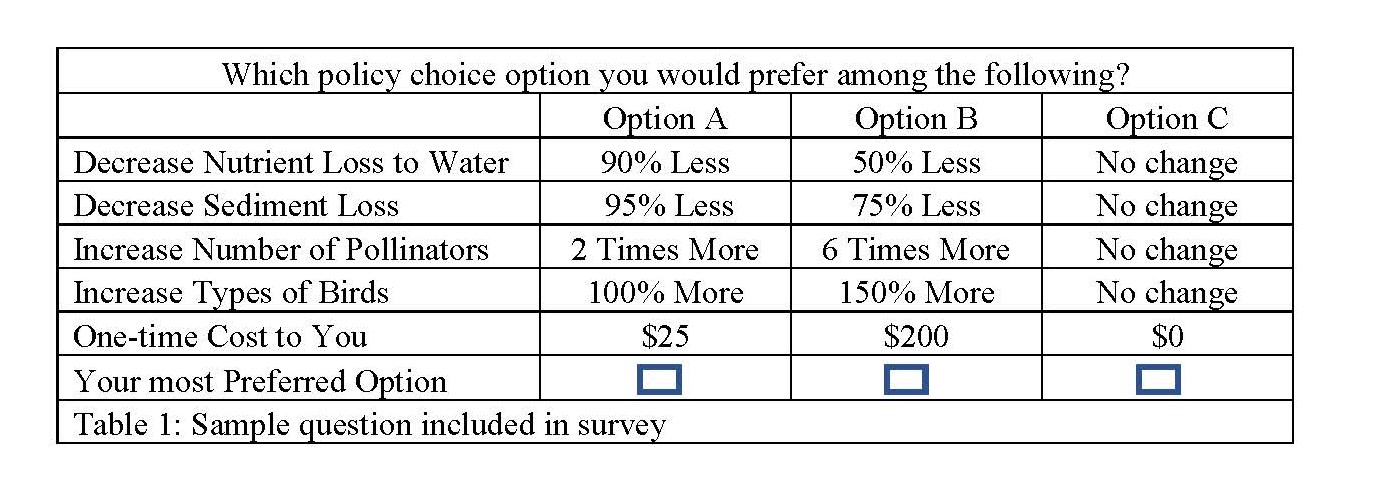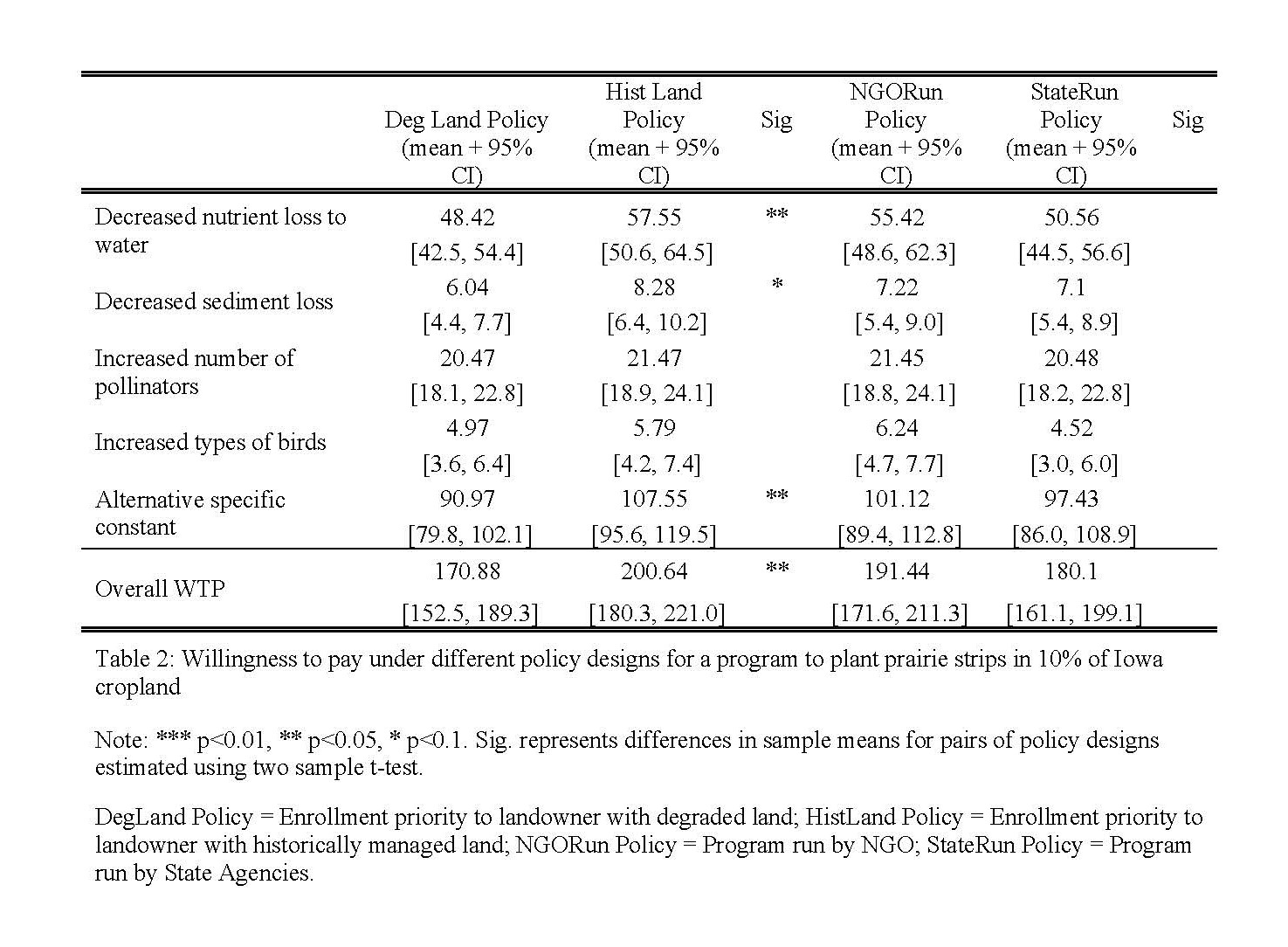Cornhusker Economics Nov 30, 2022
The Impact of Policy Design on Willingness to Pay For Ecosystem Services from Prairie Strips
Background: Ecosystem services from farmland conservation are public good benefits. The value of these benefits is primarily measured using methods that determine the willingness to pay (WTP) for those benefits. Prairie strips, a farmland conservation practice, provide ecosystem services such as improved water quality, soil health, and biodiversity (Schulte et al., 2017). The state of Iowa is a major corn producer and contributes significant amounts of nitrogen and phosphorous to the Gulf of Mexico (Alexander et al., 2008). The development of conventional agricultural systems has also resulted in a significant loss of biodiversity, including a dominant land cover of tallgrass prairie. Currently, Iowa's prairie communities cover less than 0.1 percent of the area that existed before the Euro-American settlement (Liebman et al., 2013). Prairie strips are strips of native perennial grasses and forbs within row crop fields and are shown to improve soil, water, and biodiversity (Schulte et al., 2017). The Science-based Trials of Rowcrops Integrated with Prairie Strips (STRIPS) team in Iowa has been operating as a pilot program for more than fifteen years, during which it has helped match funding to landowners to incorporate prairie strips and analyzed the impacts on environmental indicators.
The USDA Conservation Reserve Program (CRP) started in 1985 and has enrolled many acres in Iowa since its inception. The CRP acreage decreased in the recent past, from 2.20 million acres in 1994 to 1.75 million acres in 2019 in Iowa. Starting in December 2019, the USDA named prairie strips (CP-43) as a CRP-supported practice under the Clean Lakes, Estuaries and Rivers (CLEAR) initiative of the USDA.
Our contribution: In a recently published paper (see Khanal et al., 2022), we analyze the value to the public (measured as the WTP) of implementing prairie strips conservation on private land in Iowa. We also test if the WTP varies depending on how the program is designed (see Khanal et al., 2022 for additional results regarding differences by socio-economic characteristics).
We include two policy treatments in our survey, which were randomized among respondents. A treatment is a modification to the survey that allows us to measure if changes in the information provided affect how people respond to the questions. The first treatment distinguishes who has enrollment priority: landowners who have historically maintained good conservation practices or landowners with degraded land. We refer to these as `HistLand' and `Deg Land'. Existing literature suggests that one way people value outcomes is based on an accountability principle, which says that costs should be distributed based on responsibility (Johansson-Stenman and Konow, 2010). If perceived fairness affects an individual's WTP for a new conservation program, it could have substantial impacts on public support to provide resources to the program. We hypothesize that the public has a higher WTP for a program with enrollment priority to historically conserved land versus priority to degraded land for two reasons. First, the public may perceive it to be fairer to prioritize landowners who have used conservation-oriented practices in the past. Second, the public may believe that the benefits of the program would provide higher long-term benefits if priority is given to land that has had a relatively long-term conservation focus.
The second treatment differs by which agency manages the program. Past research suggests that individuals have preferences regarding who manages a program or provides information, regardless of outcomes. The impact of this treatment on WTP will depend on the trust and experience of an individual with government agencies. Under one option, the state of Iowa will manage the fund and implement the program through a state agency such as the Iowa Department of Agriculture and Land Stewardship (IDALS). Under the second option, the state will manage the fund but will contract with an external organization (an NGO) such as The Nature Conservancy to manage the program. We refer to these as `StateRun' versus `NGORun'.
Methods: The panel was recruited by Dynata (https://www.dynata.com/) and all respondents completed the survey online. Members of the survey panel previously expressed willingness to participate in research studies. The target population included all Iowa residents aged 19 or older, and the survey was conducted in November and December of 2019. The University of Nebraska Institutional Review Board (UNL-IRB) approved the survey questionnaire. The survey company ensured that all responses are confidential, and respondents signed the consent before participation in the on-line survey. The sample includes 1200 Iowa households, which were fairly representative of the Iowa population (see Khanal et al., 2022 for a comparison of the sample to the Iowa population).
Table 1 provides an example of the type of survey question used. Each respondent responded to six questions like this, and based on the responses, we can estimate how the person values the overall benefits of a conservation program that implements prairie strips, and the preferences for each of the four attributes included: decreased nutrient loss to water, decreased sediment loss, increase in the number of pollinators, and increase in the types of birds. Prior to these questions, we provide information and photos about prairie strips and the environmental benefits they provide.

Results and discussion: Using the regression results, we estimated the mean marginal WTP estimates for different policy designs and ecosystem services. Table 2 shows the estimated WTP for a state-wide program that enrolls 10% of the potential cropland and plants prairie strips on the land. Schulte et al. (2017) estimate average changes in approximately forty ecosystem services from Iowa prairie strips. Based on the range of values found in Schulte et al. (2017), we use a 75% decrease in nutrient loss to water, 95% decrease in sediment loss, 300% increase in pollinators, and 100% increase in types of birds to estimate the total WTP in our analysis. The household WTP is highest for decreased nutrient loss to water, followed by increased pollinators, decreased sediment loss, and increased types of birds, respectively, for all policy designs. The `Sig' column indicates if the difference is statistically significant between policy designs.
Our results show that households have different values across ecosystem services. The highest value (WTP) is related to water quality benefits of prairie strips, which is consistent with the findings of Arbuckle et al. (2015). This may be due to greater awareness of water quality problems in the state. There has been considerable media coverage of the issue of water contamination by nitrate leaching from agriculture fields to water bodies in Iowa. In 2015, the Des Moines Water Works (DMWW) filed a lawsuit against drainage districts in three upstream Iowa counties (Vedachalam et al., 2019). Although the lawsuit was dismissed in federal court, it shows the underlying issues of excessive use of chemical fertilizers and highlights the connection between agricultural production and poor water quality.
The HistLand policy has significantly higher WTP than DegLand policy, with overall WTP of $200.64 compared to $170.88. There are a couple possible explanations for this finding. One is that the public has a positive value for a perceived distributional equity, where those who have historically maintained strong conservation practices have enrollment priority. Another possible explanation is that the public expects the program to provide higher long-term benefits if priority is given to land that has had a relatively long-term conservation focus.
The average public WTP for the NGORun policy is higher than the StateRun policy ($191.44 compared to $180.1), although the difference is not statistically significant across all households. However, we find that for approximately 75% of the population, the difference is statistically significant with a higher WTP for an NGO Run policy (see Khanal et al., 2022 for more details).

The mean WTP is positive for all assessed land management and enrollment policies evaluated in the current study. Expanding prairie strips under a program with enrollment priority to landowners with historically managed land generates a mean value of $200.64 for the one-time WTP from Iowa households and is significantly higher than other policy designs included in the study. If the government chooses to create the program with a voter-approved referendum, our results suggest that the maximum payment that would receive support by at least 50% of households is $125.44 (see Khanal et al., 2022 for more details).
Overall, the analysis suggests that some investment in prairie strips via the CRP or other conservation programs in Iowa is justified based upon the value of resulting public and private benefits.
Acknowledgements: The authors would like to thank USDA National Institute for Food and Agriculture (grant ID: 2015-67019-23002) for funding this research. Drs. J. Arbuckle, C. Gustafson, and J. Tyndall provided important suggestions on the survey development and Dr. J. Westra provided useful input throughout the project development process.
References:
Arbuckle, J. G., Tyndall J., & Sorenson, E. (2015) Iowan's Perspectives on Targeted Approaches for Multiple‐Benefit Agriculture. Sociology Technical Reports. https://lib.dr.iastate.edu/soc_las_reports/1
Alexander, R. B., Smith, R. A., Schwarz, G. E., Boyer, E. W., Nolan, J. V., & Brakebill, J. W. (2008). Differences in phosphorus and nitrogen delivery to the Gulf of Mexico from the Mississippi River Basin. Environmental science & technology, 42(3), 822-830.
Johansson-Stenman, O., & Konow, J. (2010). Fair air: distributive justice and environmental economics. Environmental and Resource Economics, 46(2), 147-166.
Khanal, B., Schoengold, K., Mieno, T., & Schulte Moore, L. 2022. “The impact of policy design on willingness to pay for ecosystem services from prairie strips.” Journal of the Agricultural and Applied Economics Association 1: 352–369.
https://doi.org/10.1002/jaa2.33
Liebman, M., Helmers, M. J., Schulte, L. A., & Chase, C. A. (2013). Using biodiversity to link agricultural productivity with environmental quality: Results from three field experiments in Iowa. Renewable Agriculture and Food Systems, 28(2), 115-128.
Schulte, L. A., Niemi, J., Helmers, M. J., Liebman, M., Arbuckle, J. G., James, D. E., ... & Witte, C. (2017). Prairie strips improve biodiversity and the delivery of multiple ecosystem services from corn–soybean croplands. Proceedings of the National Academy of Sciences, 114(42), 11247-11252.
Vedachalam, S., Mandelia, A. J. & Heath, E. A. (2019). The Impact of Source Water Quality on the Cost of Nitrate Treatment. AWWA Water Science 1(1), e1011. https://doi.org/10.1002/aws2.1011
Authors:
Karina Schoengold
Department of Agricultural Economics
University of Nebraska-Lincoln
Badri Khanal
Center for Experimental and Applied Economics
University of Delaware
Taro Mieno
Department of Agricultural Economics
University of Nebraska-Lincoln
Lisa Schulte Moore
Natural Resource Ecology and Management
Bioeconomy Institute
Iowa State University